The apparatus composing the piece is comprised of three parts: a funnel, several open top cars, and a set of numbered balls. … The placing of notes (numbers) in the score was determined by the way in which the balls came through the funnel and were taken out of the cars. … The composition itself was determined by Duchamp in his description of the system and his examples of musical scoring(1)
click images to enlarge
- Figure 1 (recto)
- Figure 2 (verso)
Marcel Duchamp,
The Bride Stripped Bare by Her Bachelors,
Even: Musical Erratum (1913), from the Green Box (1934)
In discussing how he arrived at his implementation of Marcel Duchamp’s musical “score,”La Mariée mise à nu par ses célibataires même: Erratum Musical, (Figs. 1 and 2) for his 1987 performance of Duchamp’s music, Peter Kotik first explained the technical instructions which produced the score itself, noting that “I intentionally avoided implementing my own musical ideas. Indeed, it was a realization rather than a composition.”(2) The reason for his description of the score he used as a “realization” is simply that the score was determined by a particular kind of “chance operation” laid out in a set of instructions from 1912-1913. The kind of “chance” used by Duchamp is one where the precise sequence of a set of carefully described elements are assembled into one instance of a very large, complex permutation itself deflected from being purely mechanical through the intervention of an interpreting consciousness. What creates this situation are the lacunae left in the instructions, thus leaving aspects of the implementation uncertain, open to the interpretation of the one who sets up the apparatus and employs it. As a result, even though these works are technically deterministic–limited set of elements, limited set of possible outcomes (all the possible arrangements of notes in the score could be worked out mathematically)–the actual implementation has the character of being “random” because there is no overriding intelligence actually setting the pieces into a particular order, even though their arrangement is (paradoxically) dependent on an overriding intelligence. It is only possible to perceive the order from the vantage point of process, where each individual “score” or “implementation” is a particular instance of the rules being followed in a specific way. This is the meaning of what Duchamp terms his “chance operations.” La Mariée mise à nu par ses célibataires même. Erratum Musical (as used by Kotik) is simply one instance of those operations.
The omissions left in the instructions for these works are significant. Because there are areas which remain unknown in the how of implementation, each time these instructions are implemented, the one following the instruction is forced to “fill in” the missing details,(3)thus introducing a very significant variable into an otherwise mechanical process. It is not possible to simply sit down and perform the necessary permutations of elements (using a computer program for example) and produce the totality of all possible scores; such a construction would only result in all possible scores producible using those assumptions about how to fill in the details. Logically, different assumptions produce a different score. This is an important factor since it sets the emphasis in neither the results nor the mechanical process, but in how that mechanical process is imagined by the implementer.
click to enlarge
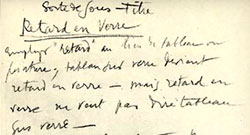
Figure 3
Marcel Duchamp,
Note from the
Green Box, 1934
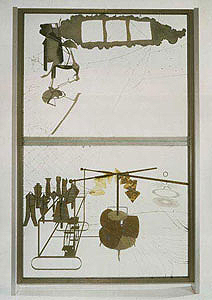
Figure 4
Marcel Duchamp,
The Bride Stripped Bare
by Her Bachelors, Even
[a k.a. The Large
Glass], 1915-23
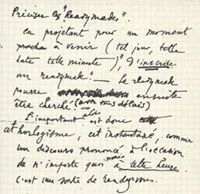
Figure 5
Marcel Duchamp,
Note from the
Green Box, 1934
On a note in the Green Box, (Fig. 3) Duchamp makes the following comment, suggestive given both the title of La Mariée mise à nu par ses célibataires même. Erratum Musical and the problem of its score:
Use ‘delay’ instead of picture or painting: ‘picture on glass’ thus becomes ‘delay in glass’–but ‘delay in glass’ does not mean ‘picture on glass’
[translator’s note: The expression “retard en verre” is a homophone of several others, notably, “retard d’envers” (delayed reversal), “retard envers” (delay in relation to/delay towards), etc.](4)
The piece is a musical notation to La Mariée mise à nu par ses célibataires, même (The Large Glass)(Fig. 4) that comes very early in the planning stages for this major work. The idea of delays, particularly “delays towards,” is useful since the apparatus produces a delay in the creation of the score, a process which is itself delayed by the points before and after the functioning of the apparatus which require interpretation to continue. It produces music whose performance is delayed by the method of its composition, putting the performer in the position of one of the “bachelors” confronted by a “bachelor machine”–a device which does not produce an artwork so much as the instructions for producing an artwork (a musical score is a set of instructions for making music, but is not itself music). At the same time, the performer who would normally “realize” the score as music is forced into the position of the composer, since the composer must provide an essential element for the realization of the instructions (hence, the creation of the music). This is the event being displayed through the bottom plane of La Mariée mise à nu par ses célibataires, même, which makes the role of “retard” (delay) a literal one: as Kotik notes, not only are the instructions for the apparatus incomplete (Duchamp’s title for the system is: An apparatus automatically recording fragmented musical periods), its functioning as a score is also left uncertain, forcing the performer to find ways of implementing it.(5) The kinds of problems associated with this score are paralleled by the instructions for the readymades, also recorded on a note in the Green Box: (Fig. 5)
| Specifications for ‘Readymades’
By planning for a moment to come (on such a day, such a date, such a minute), ‘toinscribe a readymade‘–the readymade can later be looked for–(with all kinds of delays). The important thing is just this matter of timing, this snapshot effect, like a speech delivered on no matter what occasion but at such and such an hour. It is a kind of rendez-vous.(6) |
click to enlarge
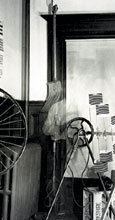
Figure 6
Marcel Duchamp,
In Advance of the
Broken Arm, 1915
(Studio Photograph)
What is notable about this description is the way that it does not mention any of the typically significant characteristics of readymades: their arbitrariness, their lack of aesthetic response, etc.(7) Instead it suggests that the decision to make a readymade comes first linguistically, for which an object is later simply picked up. For example, Snow Shovel (In Advance of the Broken Arm)(Fig. 6) may have begun as the statement, with the shovel later purchased, adjusted, and then presented as a “readymade.” This note suggests that these objects are first and foremost language–inscribed–rather than related to conventional aesthetics in either positive or negative terms. The selection is based on how well it fits the words which will be attached to it; the words come first, the readymade simply their illustration. The object is then an imaginary (subjective) connection between those words and some physical construction in the world, whereby this connection repeats the emphasis on the mind of the interpreter as decisive in the “chance” operation of discovering the score–the necessary “missing” element in Duchamp’s instructions for La Mariée mise à nu par ses célibataires même. Erratum Musical.
“Chance operations” are left “open to chance” only in the sense that the missing details of the instructions are open to interpretation in their implementation. The character of a “speech delivered on no matter what occasion but at such and such an hour” would be a statement of whatever happened to be the most recent subject of personal thought, a representation of the “desire” of that particular instant. By making this the analogy for the process–a snapshot–Duchamp implies the readymade is a presentation of his subjective moment, which is then connected to some physical support (the actual “readymade” we know) whose realisation depends on how he implements his instructions at some later moment which could include reconsideration, revision and reinterpretation (the “delays”). The initial statement limits the possible implementations, but only just. This is the same situation in La Mariée mise à nu par ses célibataires même: Erratum Musical, the apparatus with its funnel and row of boxes. As the balls fall into the boxes, they present one order which is then altered further by their being removed and ordered into the score based on another set of instructions. Further complicating this is the fact that there are six voices, but they are not specified.(8) While there are a finite number of possible arrangements in each interpretation of the instructions, it is also not directly discernable which arrangement will appear at any given moment, nor, considering the role interpretation plays in implementing the apparatus, are the results necessarily always going to be the same even if the sequence of balls is the same. Depending on how the framework for making the selection is decided based on the written instructions, different results will follow. The initial conditions of the search determine the outcome.
It is this dependence on initial conditions that renders the outcome of this process indeterminate. It is the change between one interpretative framework and another which is the significant point in this “physics,” and which is relevant to understanding the role of the interpretation of the implementer in the “measurement”:
|
Luggage Physics Determine the difference between the volumes of air displaced by a clean shirt (ironed and folded) and the same shirt when dirty.(9) |
click to enlarge

Figure 7
Marcel Duchamp,
Three Standard
Stoppages, 1913-14
While the different volumes of clean and dirty laundry may seem an absurdity, if treated seriously, one is forced to make a decision about the physical state of the dirty shirt–ironed and folded, or crumpled into a ball, or in some other state, etc.–before even being able to contemplate the possibility of measurement. Each situation will obviously result in a different value. Some of the dirty shirts would have more volume than the clean ones, while others may have the same volume, or possibly less volume; it depends on what the conditions are at the moment of measurement. This repeats the Three Standard Stoppages: (Fig. 7) we are left with an approximation of the unit of measure, rather than a singular “standard”(10)–in this case the question of what kind of shirt, state of that shirt when dirty, physical dimension of both clean and dirty shirts, etc., determines what volume results. “Chance” within this framework is the particular choices made by the implementer following the instructions, with concomitant effects on the measurements through the implementation. How the instructions apply to the situation renders an otherwise apparently mechanical, deterministic situation indeterminate. The key factor in this situation is “desire”: the desire to know the result, compounded by the (subjective) desire which directs the implementer in a particular direction. In the case of Kotik’s implementation of La Mariée mise à nu par ses célibataires même. Erratum Musical, it is his “desire” to allow the SEM Ensemble to perform this score which structures his interpretation of it.(11)
There is a dialectic opposition in this situation between defined (instructions) and undefined (interpretation / desire of interpreter). The instructions appear to produce a framework of specific limitations, a system which is then undermined at its foundation by the role an interpreter must play in order to actually follow the instructions as written. However, once that point of indeterminacy passes, the apparatus functions mechanically until another point of interpretation intervenes in its functioning, producing a “delay” in the apparatus: a stoppage. We stop, awaiting further interpretation before proceeding. This is what is meant by “chance operations”–rather than those aspects which are not left to human will and understanding, it is the human element which is the locus of “chance” itself:
| Your chance is not the same as my chance, just as your throw of the dice will rarely be the same as mine.(12) |
The process of each person doing something–which Duchamp relates directly to “chance”–is unique to that person. This is the basis of the first of the musical scores he produced: three people draw notes out of a hat. However, this kind of chance is a very simple one, where it is possible to describe all possible results through a permutation of the possibilities; the apparatus used for La Mariée mise à nu par ses célibataires même: Erratum Musical is a development and refinement of this earlier process where the permutation becomes problematic.
Duchamp has emphasized the importance of the “chance operation” being something other than the manipulation of a sequence of permutations. Simply because some of his early chance procedures (1912-1913) are reducible in these terms does not necessarily mean that this was important to his later procedures which develop from them. It is a configuration of personal possibilities. In describing the “possible,” he emphasizes the relation of the elements as other than a set of probable outcomes:
Possible
The figuration of a possible.(not as the opposite of impossible
nor as related to probable nor as subordinated to likely) possible is only a physical “caustic”[vitriol type] burning up all aesthetics or callistics(13)
The implication within this construct of “possible” is based on the physical implementation in a negative sense–the literal application reducing all outcomes to a particular one, a situation where aesthetics no longer applies because of the deterministic result. Taken in relation to “chance operations” this would be the functioning of the apparatus independent of human control. This discussion of “possible” can be understood as related to “chance operations”: the permutation of elements described in the first musical piece (also titledErratum Musical) could be produced by purely mechanical means (a process of substitution) since the elements are not so much altered through the understanding of the instructions as they are selected, then presented in a particular order–that of their selection from inside the hat. This “chance operation” is qualitatively different from that which Kotik encountered: necessary details must be supplied by the implementer. It is only through the “chance” (personal) invention of the missing details that subsequent “random” action happens. Even though when operated, the apparatus produces a sequence of elements within set parameters, the meaning of that sequence is not actually determined within Duchamp’s instructions. There are six “voices,” but the parameters and relationship of those voices is unknown. On both sides of the apparatus’ functioning there are points of unknown significance, making us aware of the gap between looking at his instructions and trying to follow them.
In spite of the emphasis on the spaces between instruction and implementation in his version of “chance operations,” Duchamp has claimed a distrust of language. However, this failure to communicate is literally necessary for the kind of “chance” his work employs. Without the problem posed by the abstraction where “you’re lost,” the human intervention is unnecessary.
|
As soon as we start putting our thoughts into words and sentences everything gets distorted. Language is just no damn good–I use it because I have to, but I don’t put any trust in it. Once I became interested in that group of philosophers in England, the ones who argue that all language tends to become tautological and therefore meaningless. I even tried to read that book of theirs on The Meaning of Meaning. I couldn’t read it, of course, couldn’t understand a word. But I agree with their idea that only a sentence like ‘the coffee is black’ has any meaning–only the fact directly perceived by the senses. The minute you go beyond that, into abstractions, you’re lost.(14) |
click to enlarge
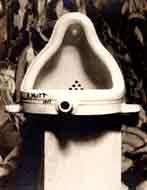
Figure 8
Marcel Duchamp,
Fountain, 1917
(Photograph by
Alfred Stieglitz, 1917)
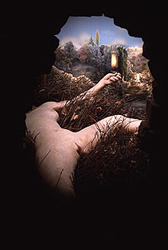
Figure 9
Marcel Duchamp, Given: 1.
The Waterfall / 2.
The Illuminating Gas,
1946-66
This statement sounds odd given the very abstract nature of his work and the high degree of misinformation Duchamp has provided over the years about it. Simply considering the many variations of the Fountain (Fig. 8) incident,(15) and the degree to which he was unwilling to provide any information about Etant Donnés (Fig. 9) during his lifetime(16) suggests that he may be providing yet more misinformation about his work and working process. Yet, these comments are suggestive considering the kinds of problems his instructions present in their implementation. They are an illustration of the difficulty which abstractions present to communication: to return to the luggage physics problem, how do we approach measuring the “dirty shirt”? While a clean and a dirty shirt do present different, individually understandable aspects, the problem is not one of clean or dirty shirts, but of deciding how to proceed with measuring them. Any measurement would either be provisional or, more likely, incomplete and contingent–an approximation based on several different measurements, as the Three Standard Stoppages refer to the meter and present approximations of the meter, but not the actual meter itself.
Underlying this whole discussion of what Duchamp says is his working process is the problem of “Can he be believed?”–presented by the intentional fallacy.(17) Whether he actually worked in the fashion he has claimed, or did something very different in actuality, is distinct from the problem posed by “chance operations.” The version of “chance” which Duchamp suggests has been (in)directly influential through its influence on John Cage.(18) This makes an examination of Duchamp’s “chance” not only appropriate, but necessary and important to evaluating his “chance operations.”
In interpreting this “chance” process we are confronted by the same problems Peter Kotik encountered in attempting to implement La Mariée mise à nu par ses célibataires même. Erratum Musical and produce his score. We are forced to look elsewhere for more details to help answer the unknown aspects of the equation. That these are things which Duchamp said does have some bearing on other things he said, and while the reconstruction here does omit certain details and emphasize others in order to create the impression of clarity, there may actually be no clarity at all. Statements made at different times in his life and edited over long periods may not be as consistent as those statements made all at once, as with a speech delivered on no matter what occasion but at such and such an hour. The idea that these “chance operations” are limited within specific frameworks gives us the possibility of a rendez-vous with his ideas of chance, but we are left uncertain as to whether we will simply find ourselves waiting at the station for a train which may never arrive.
NOTES
 1. Peter Kotik, Music by Marcel Duchamp, CD liner notes and recording, Edition Block EB-202, Berlin,1991, np.
1. Peter Kotik, Music by Marcel Duchamp, CD liner notes and recording, Edition Block EB-202, Berlin,1991, np.
 4. Pierre Cabanne, Duchamp & Co (Paris: Finest Sa/Editions Pierre Terrail, 1997) 76.
4. Pierre Cabanne, Duchamp & Co (Paris: Finest Sa/Editions Pierre Terrail, 1997) 76.
 6. Marcel Duchamp, The Writings of Marcel Duchamp, eds. Michael Sanouillet and Elmer Peterson (New York: Da Capo Press, 1989) 32.
6. Marcel Duchamp, The Writings of Marcel Duchamp, eds. Michael Sanouillet and Elmer Peterson (New York: Da Capo Press, 1989) 32.
 7.In contrast to the Green Box note, these are the characteristics which Duchamp emphasized in his later discussions of the readymades. “Apropos of ‘Readymades'” in The Writings of Marcel Duchamp, pp.
7.In contrast to the Green Box note, these are the characteristics which Duchamp emphasized in his later discussions of the readymades. “Apropos of ‘Readymades'” in The Writings of Marcel Duchamp, pp.
141-142, is typical.
 10. Rhonda Roland Shearer and Stephen Jay Gould,”Hidden in Plain Sight: Duchamp’s 3 Standard Stoppages, More Truly a “Stoppage” (An Invisible Mending) Than We Ever Realized,” in Tout-Fait 1, no. 1 (December 1999). In examining the instructions Duchamp provided for the Standard Stoppages, Shearer and Gould discovered that the set of instructions provided were not the actual system which Duchamp had used; the “meter long thread” was not dropped–instead it was sewn to its canvas support, thus producing the work in question. The actual procedure,which has always failed to produce results resembling Duchamp’s “drop” is incapable of producing the work inquestion. The relevance of the Standard Stoppages to his consideration lies in the generally held belief that they were products of that procedure, even if such a belief is an easily falsifiable intentional fallacy.
10. Rhonda Roland Shearer and Stephen Jay Gould,”Hidden in Plain Sight: Duchamp’s 3 Standard Stoppages, More Truly a “Stoppage” (An Invisible Mending) Than We Ever Realized,” in Tout-Fait 1, no. 1 (December 1999). In examining the instructions Duchamp provided for the Standard Stoppages, Shearer and Gould discovered that the set of instructions provided were not the actual system which Duchamp had used; the “meter long thread” was not dropped–instead it was sewn to its canvas support, thus producing the work in question. The actual procedure,which has always failed to produce results resembling Duchamp’s “drop” is incapable of producing the work inquestion. The relevance of the Standard Stoppages to his consideration lies in the generally held belief that they were products of that procedure, even if such a belief is an easily falsifiable intentional fallacy.
 12. Calvin Tomkins, The Bride and the Bachelors (New York: Penguin, 1968) 33.
12. Calvin Tomkins, The Bride and the Bachelors (New York: Penguin, 1968) 33.
 15. William Camfield, Fountain (Houston: Houston Fine Art Press, 1989).
15. William Camfield, Fountain (Houston: Houston Fine Art Press, 1989).
 16. Bonnie Clearwater, ed., West Coast Duchamp (Miami Beach: Grassfield Press, 1991) 70.
16. Bonnie Clearwater, ed., West Coast Duchamp (Miami Beach: Grassfield Press, 1991) 70.
 17. Monroe Beardsley, Aesthetics: Problems in the Philosophy of Criticism (New York: Harcourt
17. Monroe Beardsley, Aesthetics: Problems in the Philosophy of Criticism (New York: Harcourt
Brace, 1958).
 18. Richard Kostelanetz, ed., John Cage, (New York: Praeger, 1970) 171.
18. Richard Kostelanetz, ed., John Cage, (New York: Praeger, 1970) 171.
Figs. 1-9
©2002 Succession Marcel Duchamp, ARS, N.Y./ADAGP, Paris. All rights reserved.





